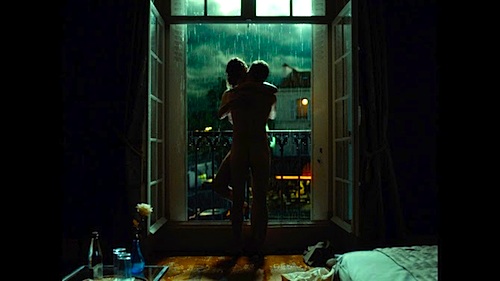By Joe Bendel. In a provincial town, there is no such thing as a no-tell motel. Nevertheless, Julien Gahyde thought he was being discrete in his regular meetings with the village pharmacy owner’s wife in the titular chambre bleue. Inconveniently, he learns that their affair was largely common knowledge when he becomes ensnared in a murder inquiry. Just who was killed by whom will be slowly revealed in Mathieu Amalric’s adaptation of the Georges Simenon novel The Blue Room, which screens during the 52nd New York Film Festival.
After a long absence, Gahyde returned to his home town, making good as a John Deere sales rep. It probably was not just lust that drove him into an affair with the sensual Esther Despierre. She also happens to be married to an old classmate, whose wealth and privilege Gahyde always resented. Regardless, her talk about a more permanent arrangement does not sit well with Gahyde, so he uses a near miss with her husband as a pretext for a cooling off period. However, her reckless letters portend bad things. Before long, Gahyde is in prison, fielding questions from the investigating magistrate, but the film’s fractured temporal-hopping narrative structure jealously guards its secrets.
One thing is certain: Gahyde is in a mess of legal trouble. Even if he is technically not guilty, he still bears considerable responsibility for the state of affairs. Amalric and editor François Gédigier keep audiences on their toes with their frequent cuts, often emphasizing oddly elliptical perspectives. There is more than a hint of the old school Nouvelle Vague in their almost Pointillistic approach. (Coincidentally, one of Picasso’s best known Blue Period paintings was also called The Blue Room and it fits the spirit of Amalric’s picture rather well.) Yet, what most distinguishes the film is the degree to which Amalric captures the vibe and essence of Simenon’s non-Maigret hothouse psychological thrillers.

Director-co-screenwriter Amalric also gives himself an important assist, portraying the thoroughly compromised and increasingly confused Gahyde. There is something Kafka-esque about the weasely philanderer that inspires rapt fascination. Frankly, both Madame Gahyde and Despierre are rendered somewhat simplistically, as the standard-issue wronged wife and Fatal Attraction mistress, respectively. However, in what might appear to be a disposable role, Serge Bozon (another actor turned director), adds a hard to quantify dimension, hinting there is much more churning beneath his magistrate’s poker face façade.
Amalric nicely distinguishes himself as a triple threat with Blue Room. Brainy and rather steamy at times, The Blue Room belongs in the top rank of Simenon adaptations, in the company of films from the likes of Chabrol, Leconte, and Duvivier. Recommended for fans of mature literary thrillers, The Blue Room screened this Monday (9/29) at Alice Tully Hall and Tuesday (9/30) at the Beale, as part of this year’s NYFF, in advance of its opening at the IFC Center this Friday (10/3).
LFM GRADE: A-
Posted on September 30th, 2014 at 10:07pm.